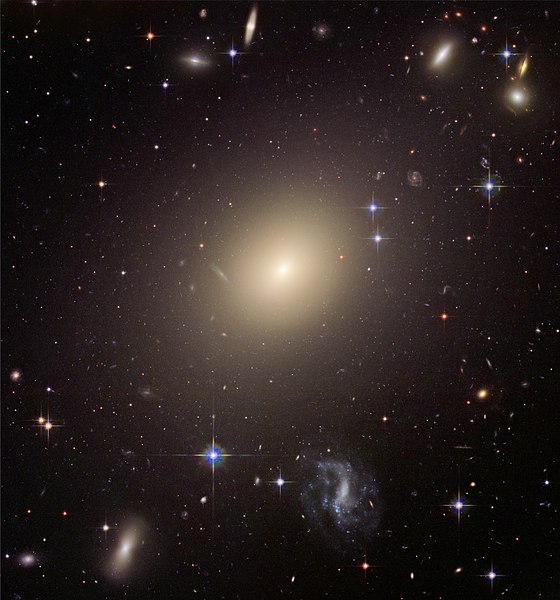Present
Facts for Kids
An elliptical galaxy is a type of galaxy with an approximately ellipsoidal shape and a smooth, nearly featureless image.


Explore the internet with AstroSafe
Search safely, manage screen time, and remove ads and inappropriate content with the AstroSafe Browser.
Download
Inside this Article
Did you know?
🌌 Elliptical galaxies have an oval shape, making them different from spiral galaxies.
🌠 About 10,000 elliptical galaxies are believed to exist in our universe!
🪐 The largest elliptical galaxy, IC 1101, is about 6 million light-years wide.
🌟 Elliptical galaxies are generally older and contain fewer young stars than spiral galaxies.
🎱 These galaxies appear smooth and featureless, looking like fuzzy balls.
🌑 Most elliptical galaxies have a supermassive black hole at their center.
🍩 Elliptical galaxies can form by merging smaller galaxies over billions of years.
🔭 Elliptical galaxies are categorized from E0 to E7 based on how round or flat they are.
🚀 E0 galaxies are nearly round while E7 galaxies are very stretched out like a pancake.
🌌 The stars in elliptical galaxies are mostly older and redder, not blue and young.
Show Less

Become a Creator with DIY.org
A safe online space featuring over 5,000 challenges to create, explore and learn in.
Learn more
Overview
Elliptical galaxies are fascinating space objects! 🌌
These galaxies have an egg or oval shape, making them different from other types like spiral galaxies. They are mostly made of stars, gas, and dust. Scientists believe there are about 10,000 of these galaxies in our universe! Most of them are found far away, more than 1 million light-years from Earth. 🪐
The biggest elliptical galaxy, called IC 1101, is located in the Abell 2029 cluster and is about 6 million light-years wide! Elliptical galaxies are older and have fewer young stars compared to their spiral cousins. 🌟
These galaxies have an egg or oval shape, making them different from other types like spiral galaxies. They are mostly made of stars, gas, and dust. Scientists believe there are about 10,000 of these galaxies in our universe! Most of them are found far away, more than 1 million light-years from Earth. 🪐
The biggest elliptical galaxy, called IC 1101, is located in the Abell 2029 cluster and is about 6 million light-years wide! Elliptical galaxies are older and have fewer young stars compared to their spiral cousins. 🌟
Read Less
Types of Elliptical Galaxies
There are different types of elliptical galaxies, which scientists categorize using letters. They range from E0 to E7! The number describes how "flat" or "round" the galaxy is. E0 galaxies are nearly as round as a circle, while E7 galaxies are very elongated, looking more like a pancake! 🥞
Most elliptical galaxies fall into the E0–E5 category, with E5 being the most common. 🌌
Most elliptical galaxies fall into the E0–E5 category, with E5 being the most common. 🌌
Read Less
Characteristics and Structure
Elliptical galaxies are known for their smooth and featureless appearance. Unlike spiral galaxies with spinning arms, they look like fuzzy balls! 🎱
Their stars are mostly older and redder, which means there aren’t many young, blue stars! 🌟
The stars in elliptical galaxies are arranged randomly, not in neat patterns. They also have little gas and dust, so new stars don’t form easily. The centers of these galaxies often have a supermassive black hole! 🌑
This black hole can be millions of times heavier than our Sun and helps hold the galaxy together.
Their stars are mostly older and redder, which means there aren’t many young, blue stars! 🌟
The stars in elliptical galaxies are arranged randomly, not in neat patterns. They also have little gas and dust, so new stars don’t form easily. The centers of these galaxies often have a supermassive black hole! 🌑
This black hole can be millions of times heavier than our Sun and helps hold the galaxy together.
Read Less
Formation of Elliptical Galaxies
Elliptical galaxies form in a few exciting ways! One popular idea is that they are created from the merging of smaller galaxies. When galaxies bump into each other, they can combine and take on an elliptical shape. This can happen over billions of years! 🌠
Another way they form is through the slow-moving gas and dust clumping together due to gravity. This process, called "collapse," helps create stars and leads to the formation of an elliptical galaxy. 🌌
Understanding how they develop helps astronomers learn more about the universe's history!
Another way they form is through the slow-moving gas and dust clumping together due to gravity. This process, called "collapse," helps create stars and leads to the formation of an elliptical galaxy. 🌌
Understanding how they develop helps astronomers learn more about the universe's history!
Read Less
Try your luck with the Elliptical Galaxy Quiz.
Try this Elliptical Galaxy quiz and see how many you score!
Q1
Question 1 of 10
Next
Explore More